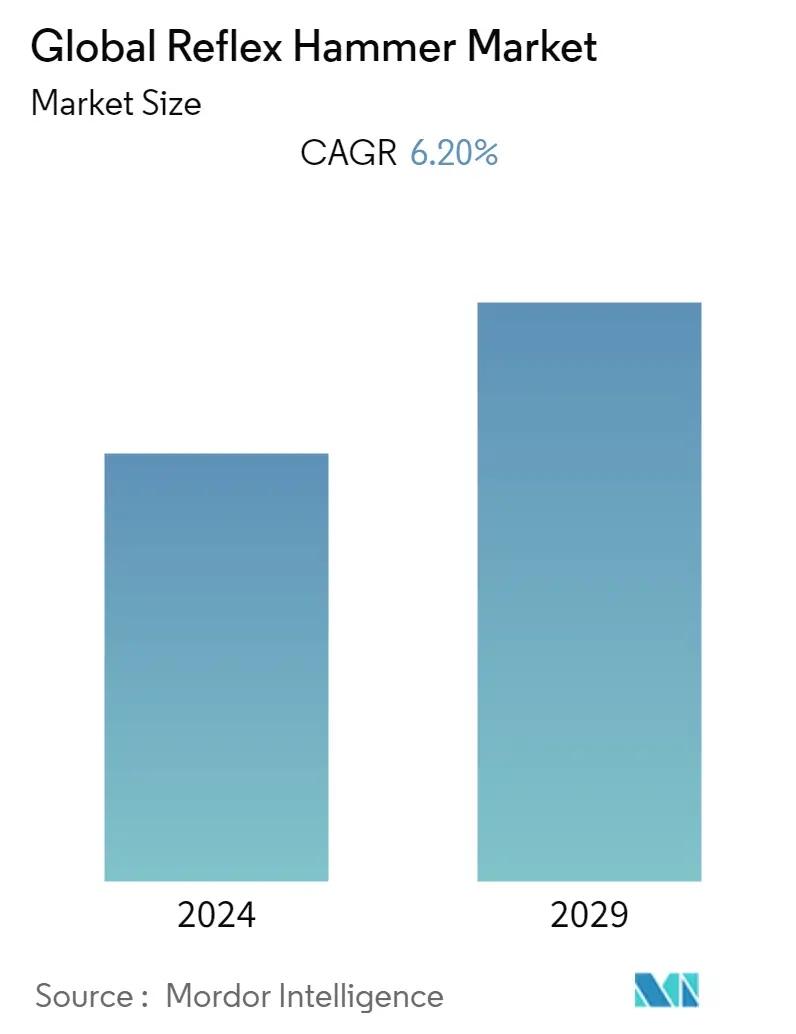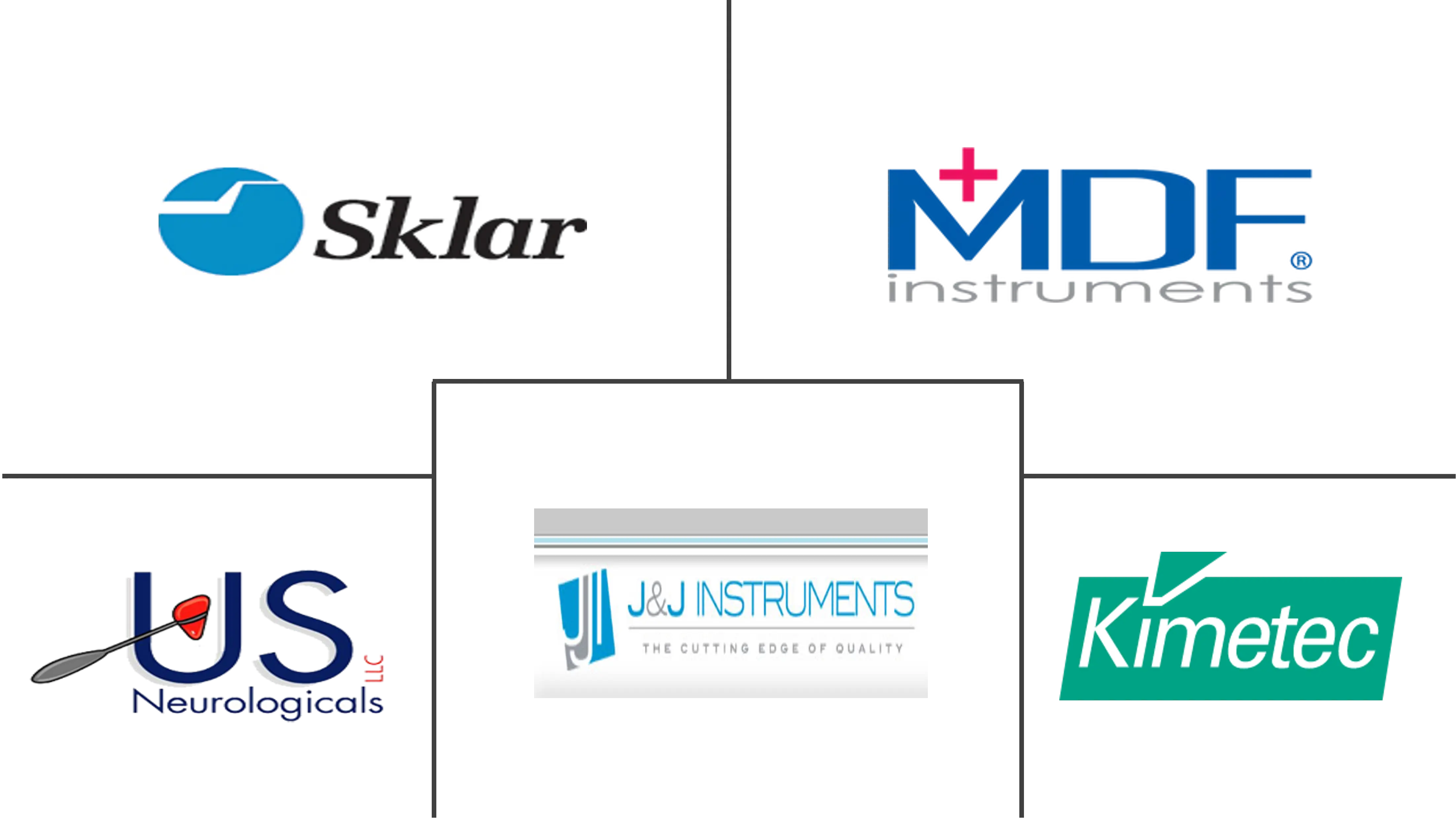Market Size of Global Reflex Hammer Industry

| Study Period | 2019 - 2029 |
| Base Year For Estimation | 2023 |
| CAGR | 6.20 % |
| Fastest Growing Market | Asia-Pacific |
| Largest Market | North America |
| Market Concentration | Medium |
Major Players
*Disclaimer: Major Players sorted in no particular order |
Reflex Hammer Market Analysis
The Reflex Hammer market is expected to witness an estimated CAGR of 6.2% over the forecast period (2022-2027).
Globally, the rising number of COVID-19 cases has had a profound impact on the reflex hammer market, as diagnostic and surgical procedures initially had to be postponed or delayed. For instance, according to the research study published in the National Library of Medicine in November 2021, titled "Neurosurgery and Coronavirus: Impact and Challenges-Lessons Learned from the First Wave of a Global Pandemic," there has been a reduction in neurosurgical emergencies by 33.6% and operations by 55.6% during the COVID times. As reflex hammers are used for the diagnosis of the reflex of the tendon, mostly in neurological conditions, the demand for these products reduced substantially. However, after regaining normalcy and resuming diagnostic procedures worldwide, patients are recommencing their treatments and check-ups for several other diseases that may have a positive impact on the reflex hammer industry in the near future. Hence, considering all the COVID-19 and post-COVID-19 impacts, the studied market is expected to have a steady growth rate during the forecast period.
Further, factors driving the market growth are an increase in the number of patients suffering from musculoskeletal and neurological disorders along with growth in patient examinations and awareness. Additionally, a rise in the commercial availability of products and growing healthcare expenditure for improving healthcare services are some of the major factors propelling the market growth.
Growing awareness among healthcare professionals, as well as a surge in the patient population, are some of the major factors that are anticipated to have a positive impact on the market growth. The main purpose of the reflex hammer is to diagnose neurological disorders that range from a headache to Alzheimer's disease, getting a stroke, or epilepsy. As per the data published by the Texas Department of State Health Services in June 2021, 6.2 million people in the United States are affected by Alzheimer's disease, and 3.4 million people are affected by epilepsy. Moreover, neurological diseases are the second leading cause of death globally, particularly with the increase in the elderly population. This number seems to rise, leading to the higher usage and demand for early diagnosis. This is likely to increase the adoption of reflex hammers across healthcare diagnostic settings.
Moreover, as per the September 2020 published article titled "World Brain Day 2020: Move Together to End Parkinson's Disease", neurological disorders are a leading cause of death worldwide. Neurological disorders were responsible for approximately 9 million deaths, or approximately 16.5% of all global fatalities. Parkinson's disease and Alzheimer's disease are two of the most common illnesses, and their prevalence has been steadily increasing. Such an increase in the prevalence of diseases is expected to impel the rate of diagnosis, ultimately fueling the market's growth over the coming years.
On the other hand, higher costs associated with reflex hammers can act as a restraining factor for the market.
Reflex Hammer Industry Segmentation
As per the scope of the report, reflex hammers are used by physicians to test the deep tendon reflexes and are used in oral examinations as well. These are mainly used for diagnostic purposes. Reflex Hammer Market is segmented by Type (Pediatric Hammers, Buck style, Tromner, Babinsky/Rabiner, and Miscellaneous Styles), By End User (Hospitals, Clinics, and Others), Geography (North America, Europe, Asia-Pacific, and Rest of the World). The market report also covers the estimated market sizes and trends for 17 different countries across major regions, globally. The report offers the value (in USD million) for the above segments.
| By Type | |
| Pediatric Hammers | |
| Buck Style | |
| Tromner | |
| Taylor Design | |
| Babinsky or Rabiner | |
| Miscellaneous styles |
| By End user | |
| Hospitals | |
| Clinics | |
| Others |
| Geography | ||||||||
| ||||||||
| ||||||||
| ||||||||
| Rest of the World |
Global Reflex Hammer Market Size Summary
The reflex hammer market is poised for steady growth over the forecast period, driven by an increase in the prevalence of musculoskeletal and neurological disorders. The market experienced a temporary setback due to the COVID-19 pandemic, which led to delays in diagnostic and surgical procedures. However, as healthcare systems worldwide have resumed normal operations, the demand for reflex hammers is expected to rise. This resurgence is fueled by the growing need for early diagnosis of neurological conditions, such as Alzheimer's and epilepsy, which are becoming more prevalent, particularly among the elderly population. The market is further bolstered by the increasing awareness among healthcare professionals and patients, alongside the expansion of healthcare services and expenditure.
In North America, the market is expected to benefit from the robust growth of healthcare technology and the rising burden of neurodegenerative diseases. The demand for reflex hammers is anticipated to increase as the need for early diagnosis and treatment becomes more critical. The market is moderately competitive, with several key players dominating the landscape. These include US Neurological, Desco Medical, and MDF Instruments, among others. The market's growth is also supported by advancements in medical research and the introduction of innovative products, such as the Smart Tendon Hammer System, which enhances the reflex examination process. As the number of surgical procedures rises and awareness of neurological disorders grows, the reflex hammer market is set to expand, with regional players expected to contribute to its development.
Global Reflex Hammer Market Size - Table of Contents
-
1. MARKET DYNAMICS
-
1.1 Market Overview
-
1.2 Market Drivers
-
1.2.1 Increase in Patients Suffering from Musculoskeletal and Neuological Disorders
-
1.2.2 Rise in Patient Examinations and Awareness Regarding Early Diagnosis
-
-
1.3 Market Restraints
-
1.3.1 Higher Costs associated with Reflex Hammer
-
-
1.4 Porter's Five Forces Analysis
-
1.4.1 Threat of New Entrants
-
1.4.2 Bargaining Power of Buyers/Consumers
-
1.4.3 Bargaining Power of Suppliers
-
1.4.4 Threat of Substitute Products
-
1.4.5 Intensity of Competitive Rivalry
-
-
-
2. MARKET SEGMENTATION (Market Size by Value - USD million)
-
2.1 By Type
-
2.1.1 Pediatric Hammers
-
2.1.2 Buck Style
-
2.1.3 Tromner
-
2.1.4 Taylor Design
-
2.1.5 Babinsky or Rabiner
-
2.1.6 Miscellaneous styles
-
-
2.2 By End user
-
2.2.1 Hospitals
-
2.2.2 Clinics
-
2.2.3 Others
-
-
2.3 Geography
-
2.3.1 North America
-
2.3.1.1 United States
-
2.3.1.2 Canada
-
2.3.1.3 Mexico
-
-
2.3.2 Europe
-
2.3.2.1 Germany
-
2.3.2.2 United Kingdom
-
2.3.2.3 France
-
2.3.2.4 Italy
-
2.3.2.5 Spain
-
2.3.2.6 Rest of Europe
-
-
2.3.3 Asia-Pacific
-
2.3.3.1 China
-
2.3.3.2 Japan
-
2.3.3.3 India
-
2.3.3.4 Australia
-
2.3.3.5 South Korea
-
2.3.3.6 Rest of Asia-Pacific
-
-
2.3.4 Rest of the World
-
-
Global Reflex Hammer Market Size FAQs
What is the current Global Reflex Hammer Market size?
The Global Reflex Hammer Market is projected to register a CAGR of 6.20% during the forecast period (2024-2029)
Who are the key players in Global Reflex Hammer Market?
Sklar Surgical Instruments, US Neurologicals LLC, J and J Instruments, Inc, Kimetec GmbH and MDF Instruments are the major companies operating in the Global Reflex Hammer Market.

